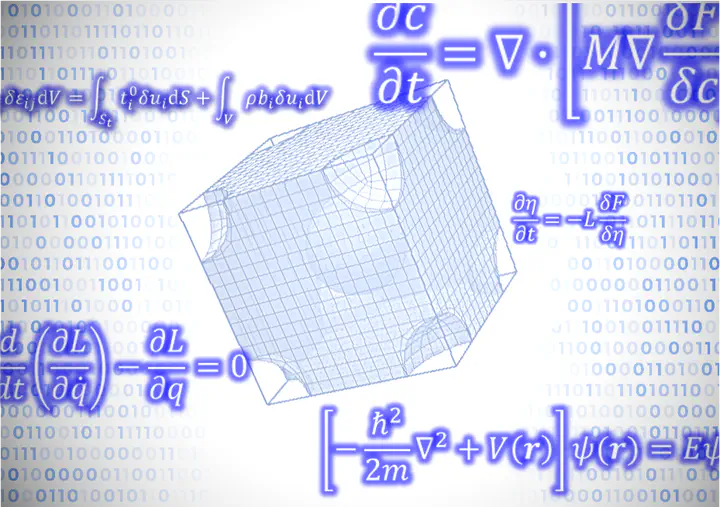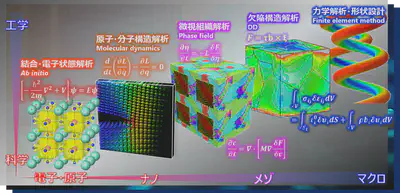Development of Materials Theory & Computational Techniqes

Fusion of Computational/Data Science to Unravel Material World
By solving physical laws and simulating the real world in a computer, we can reveal phenomena that cannot be seen/understood experimentally. In addition to state-of-the-art solid state physics theory and the development of proprietary materials analysis software, we are also integrating with data science such as machine learning.
Development of Theory & Computational Techniques for Materials Science & Mechanics
-Travel material world via governing equations-
Since the development of ENIAC, the world’s first electronic computer, the computing power of computers has grown dramatically. Nowadays, numerical simulations can reproduce various phenomena in the real world, and they have become indispensable scientific and engineering tools for research and development and product design, where competition is accelerating on a global scale. In the future, numerical simulation technology will become more and more important in all industrial fields as it is combined with information science technologies such as AI, machine learning, and deep learning.
We are developing technologies to elucidate the governing laws of strength and function from nano- to macroscopic perspectives, and to create and design material functions in an integrated manner from all scales by combining and integrating advanced theoretical analysis techniques such as molecular dynamics and first-principles quantum mechanical analysis to analyze the arrangement of atoms and the bonding state of electrons that make up materials, meso-scale methods such as the phase-field method to analyze material structure and defect structure, and the finite element method to design macroscopic shapes from stress and strain fields.

Related Publication
-
Takahiro Shimada, Satoru Okawa, Shinichiro Minami, Takayuki Kitamura
Simplified evaluation of mechanical instability in large-scale atomic structures
Materials Science & Engineering A, 513-514, 166 (2009) -
Yoshitaka Umeno, Takahiro Shimada, Takayuki Kitamura
Dislocation nucleation in a thin Cu film from molecular dynamics simulations: Instability activation by thermal fluctuations
Physical Review B, 82, 104108 (2010) -
Takahiro Shimada, Kenji Ouchi, Ichiro Ikeda, Yoshiyuki Ishii, Takayuki Kitamura
Magnetic instability criterion for spin-lattice systems
Computational Materials Science, 97, 216 (2015) -
Le Vab Lich, Takahiro Shimada, Jie Wang, Takayuki Kitamura
Instability criterion for ferroelectrics under mechanical/electric multi-fields: Ginzburg-Landau theory based modeling
Acta Materialia, 112, 1 (2016) -
Yu Wang, Jie Wang, Takayuki Kitamura, Hiroyuki Hirakata, Takahiro Shimada
Effective modeling of magnitude-fluctuated magnetization dynamics: Dynamic precursor effect in magnets
Physical Review B, 106, 094423 (2022)
-Development of new method for material design-
To understand the unique properties that arise from non-trivial electronic structures, it may be necessary to analyze them from a different perspective than what already exists. We aim to develop a new analytical method to evaluate electronic properties and establish guidelines and guiding principles for material design.
Related Publication
-
Susumu Minami, Itaru Sugita, Ryosuke Tomita, Hiroyuki Oshima, Mineo Saito
Group-theoretical analysis of two-dimensional hexagonal materials
Japanese Journal of Applied Physics 56, 105102, (2017) -
Susumu Minami, Fumiyuki Ishii, Motoaki Hirayama, Takuya Nomoto, Takashi Koretsune, Ryotaro Arita
Enhancement of the transverse thermoelectric conductivity originating from stationary points in nodal lines
Physical Review B 102, 205128 (2020)